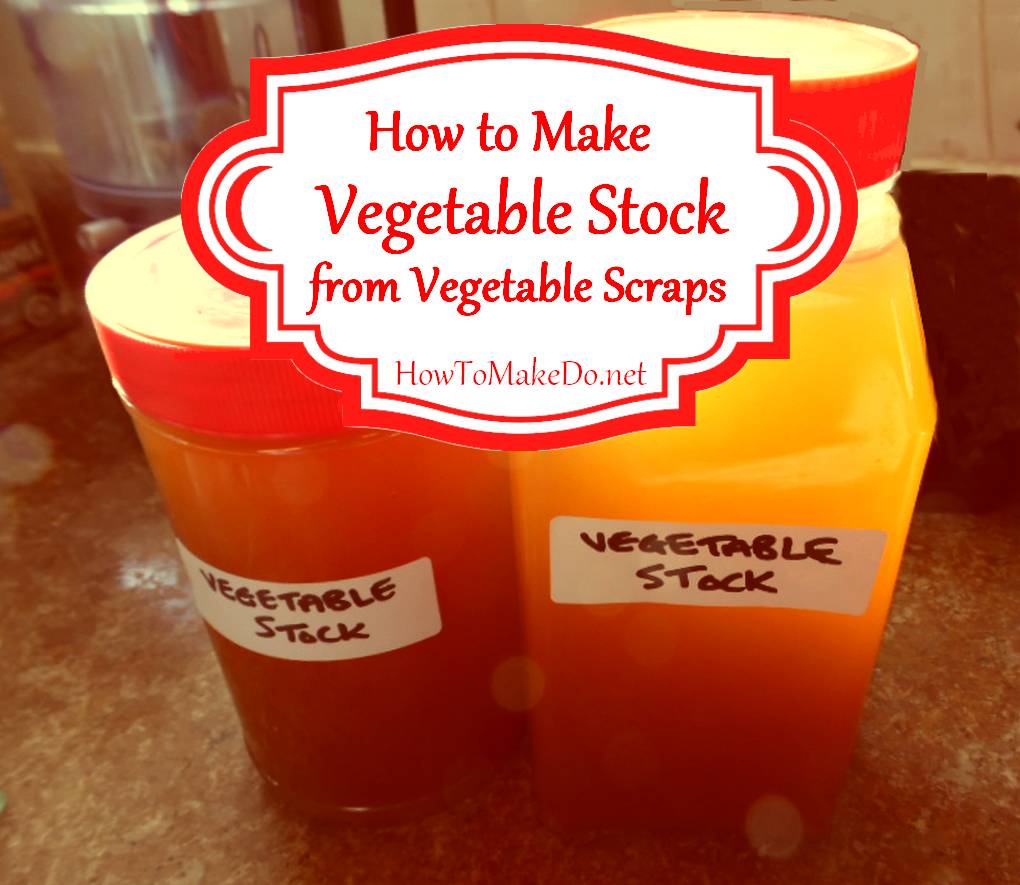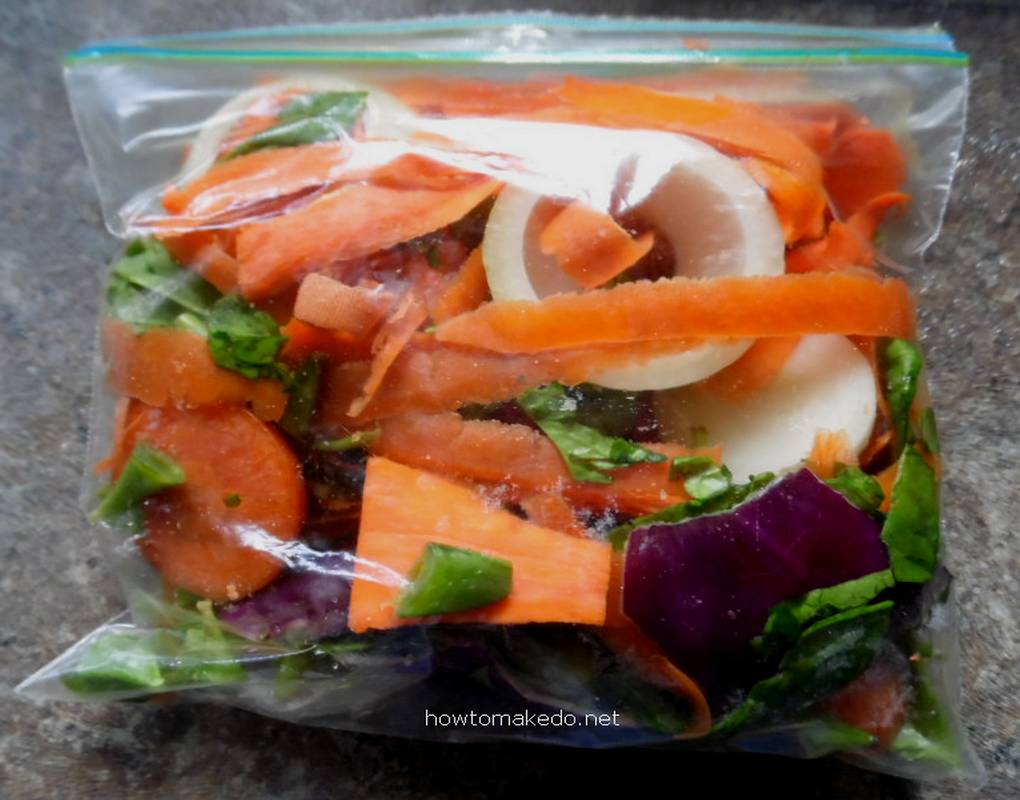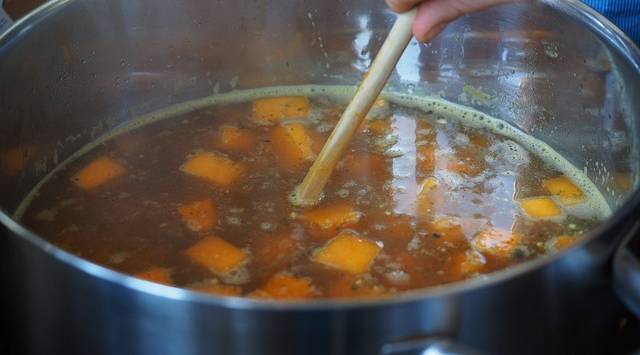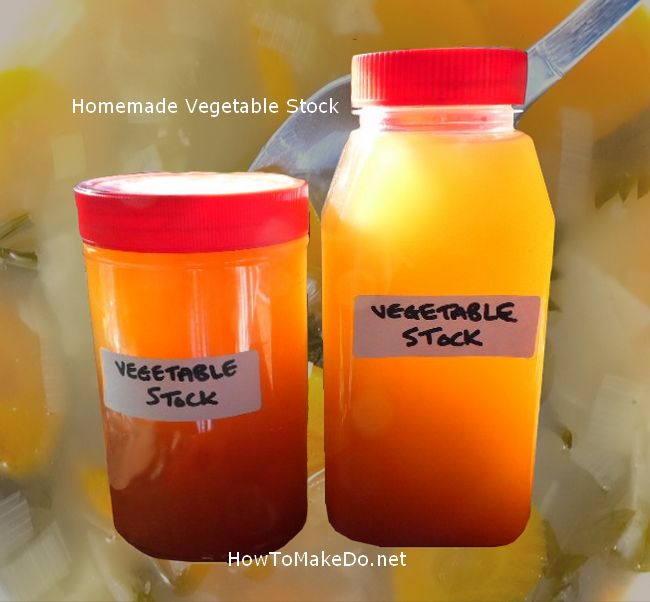Last updated on April 17th, 2024 at 03:14 pm
How to make homemade vegetable stock or vegetable broth from onions, carrots and celery plus vegetable scraps and seasonings.

This is a money-saving recipe using kitchen vegetable scraps as the base for delicious, nutritious stock.
I make large batches then freeze portions in old plastic mayonaise jars, or ziplock bags, just enough to start off soups, stews or casseroles.
HOMEMADE VEGETABLE BROTH
INGREDIENTS
- VEGETABLES
- 2 large carrots chopped into two inch pieces
- 2 large onions coarsely chopped
- 3 stalks celery chopped into two inch pieces
- 2 – 3 cups assorted vegetable scraps
- 8 cups water
- BASIC HERBS AND SEASONINGS
- 1 teaspoon ground pepper to taste
- 1- 2 tablespoons dried parsley to taste
- 2 – 4 teaspoons salt to taste
- 4-5 cloves garlic (coarsely chopped) optional
INSTRUCTIONS
- Simply add water to the stock pot, throw in the chopped onions, carrots and celery, then turn up the heat until the water comes to a boil. While the water gets hotter, add at least two cups of your vegetable scraps stash.

- Once the stock is simmering, turn the heat down to low or medium, just enough to keep it gently simmering for about an hour. During this time, do a taste test, adding more water as necessary. Add and adjust the seasonings. (See Notes, below, for more optional vegetables and seasonings)..

- When the vegetables are softened and the broth has been simmering for an hour or so, remove the stock pot from the heat and let cool. Pour cooled stock through a fine wire mesh strainer into a measuring jug and from there into plastic or glass containers. Compost the leftover vegetable mush.

- Tighten jar lids and store broth for up to a week in the fridge or six months in the freezer.

NOTES
VEGETABLE SCRAPS: THESE MIGHT INCLUDE STALKS, STEMS, LEAVES, PARINGS, SKINS, CHUNKS OR LEFTOVER VEGETABLES THAT ARE PAST THEIR PRIME BUT NOT ROTTEN, MUSHY OR MOLDY. I ALSO ADD THE LAST BITS OF FROZEN VEGETABLE PACKAGES.
BASE VEGGIES: THESE ARE THE “MEAT AND BONES” OF VEGETABLE STOCK. A COMBINATION OF THE FOLLOWING VEGETABLES SHOULD FORM THE BULK OF THE VEGETABLES IN YOUR STOCK POT. WASH AWAY DIRT OR GRIME AND REMOVE ANY PESTICIDE RESIDUE, BY SOAKING IN VINEGAR WATER, BEFORE FREEZING.
- carrots (chunks or peels, tops, bottoms – but avoid the green feathery leaves)
- celery (ribs, stems and leaves)
- green beens
- leeks (especially the green parts discarded in other recipes; just wash well to remove grit between layers)
- onions – cooking, yellow, red, green; all kinds of onions, including small amounts of onion skins which add color to the broth
- parsnips – strong flavor, so keep to small amounts
- peas – a handful or so of peas, or the tops and tails of pea pods
- scallions or shallots
- spinach – nice to add in the last few minutes of cooking
- sweet peppers – personal preference here, as some people don’t like peppers
- zucchini – small amounts are fine
UNSUITABLE VEGETABLES: SOME VEGETABLES WILL CLOUD YOUR BROTH, WHILE OTHERS ADD TOO MUCH BITTERNESS OR EARTHINESS. LEAVE THE FOLLOWING VEGETABLES OUT OF YOUR STOCK POT:
- Members of the brassica family are, in general, too bitter. These include arugula, bok choy, brussels sprouts, cabbage, cauliflower, collard or mustard greens, kohlrabi, rutabaga, turnips and turnip greens
- Starchy vegetables include potatoes, pumpkins, squash and sweet potatoes.
SEASONINGS: I INCLUDE PARSLEY IN MY BROTH, NO MATTER WHAT, PREFERABLY FRESH AND FINELY CHOPPED, BUT DRIED IF NEEDS MUST. OTHER DELECTABLE ADDITIONS INCLUDE BASIL, GARLIC, MARJORMA, OREGANO, ROSEMARY AND TYME.
Each imparts a distinct flavor to your vegetable broth, so do a sample test test: remove a ladle bowl of the cooking broth and add a smidgen of the herb under consideration. Taste. If it works for you (and your ultimate plans for the broth) add a conservative portion to the stock pot. That might be a few tablespoons for fresh parsley, or just a teaspoon of oregano or thyme. Taste again, add more if needed, and stop when you reach…delicious!
